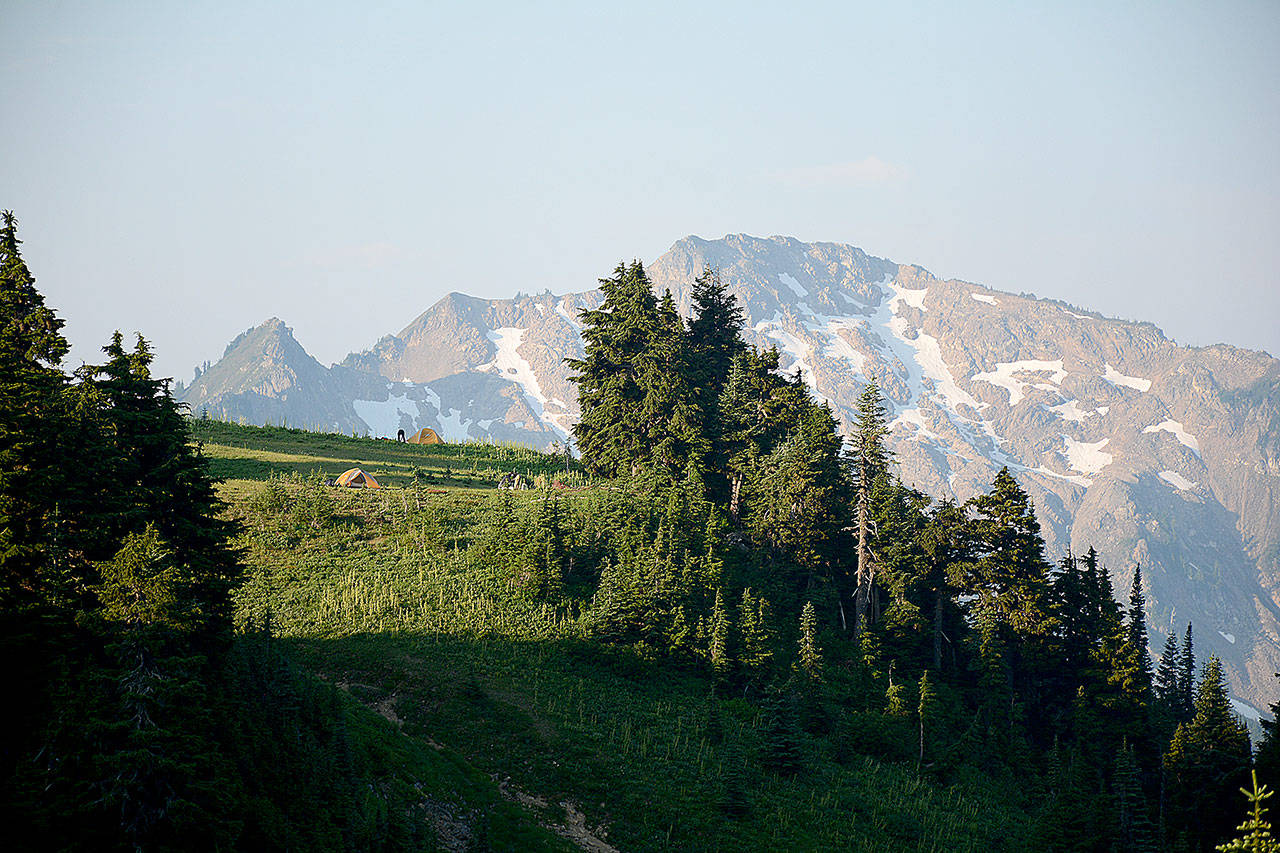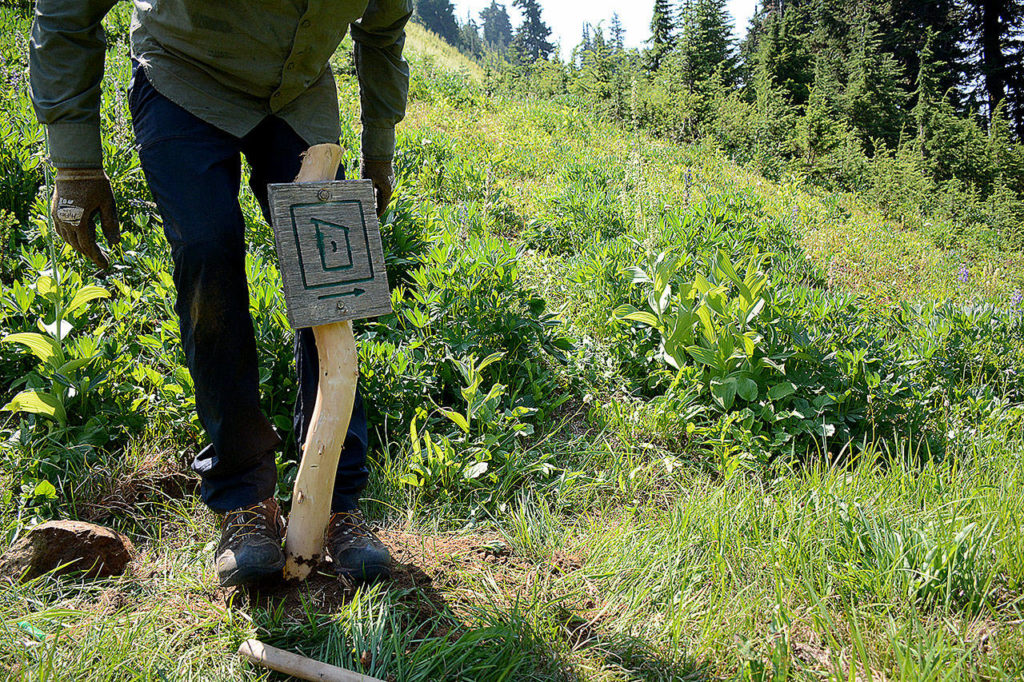By Loren Drummond
Washington Trails Association
Washington’s backcountry trails are more popular than ever, but decades of budget cuts have wreaked havoc on wilderness infrastructure, creating problems with no easy solution.
Managing poop, it turns out, is one of those problems.
“The most difficult thing with finding a new place to put a toilet is not accidentally digging into previous years’ toilets,” said Madi Hatfield, the U.S. Forest Service crew leader for the Darrington District on Mt. Baker-Snoqualmie National Forest, standing hip deep in a hole she had dug at remote White Pass in Glacier Peak Wilderness. “Three years ago, here, I was digging and the corner of my hole hit an old hole, and it was not decomposed. It looked like regular poop.”
Moving privy sites is physical work, and Hatfield’s team of five had three toilets to dig and move in a day. It was late July, and the three backcountry toilets in the sprawling meadow of established campsites were full — not-safe-to-sit-down full.
“It’s become a huge problem,” said Bridget Wisniewski, a forestry technician for the Forest Service who has been working with the Darrington Ranger District since 1988.
A popular climbing route, and located along the Pacific Crest Trail, White Pass is a high-traffic area, and the toilets fill up every year. But at White Pass, like in many areas around the state, land managers are running out of places to relocate backcountry privies. Chronic funding cuts to public lands, coupled with a burgeoning interest in visiting our state’s backcountry, are compounding the problem.
“You can’t be moving a toilet every year,” Wisniewski said. “You’re going to run out of real estate.”
Where does it go?
For decades, national forests and parks have taken the approach of locating privies near a grouped set of sites in hopes of concentrating human waste and reducing its impact on the environment. But convincing hikers to go where you want them to is only the first step in managing backcountry waste, explained Geoff Hill, a climber-turned-scientist who earned his Ph.D. researching backcountry waste management after learning that a former pit toilet site in Rocky Mountain National Park had barely decomposed after 40 years. According to Hill, you also have to decide what to do with that waste.
In some areas, pit toilets are capped, with the waste buried in place. But spurred in part by lack of space, and in part by environmental concerns, national parks are moving away from pit toilets and toward vaults, which store human waste before it can be removed from the parks. At Seven Lakes Basin, a popular backcountry camp in Olympic National Park, there’s a lineup of waste containers behind the central privy, each waiting their turn.
In Washington’s iconic Enchantments region in the Alpine Lakes Wilderness, the Forest Service also removes some hiker waste by helicopter. At the end of last season, 19 vault toilets from five sites, each full of 40 gallons of human excrement, were flown out of the Enchantments. Rangers also buried 532 piles of human waste found on the ground.
In some parks, waste is packed out by rangers or pack animals. Many areas, however, aren’t suited to a pack-out program, Hill said. And, Wisniewski explained, even getting pack support for basic trail work grows more difficult and expensive as forest roads deteriorate; the horse trailers or waste vacuum trucks for trailhead toilets simply can’t negotiate the roads safely. Removing waste from high-use backcountry sites takes resources. And resources are in shorter and shorter supply these days.
A toilet-tech solution?
Hill said waste separation is at least one part of the solution facing public lands. If you can divert pee (a relatively benign waste product that most alpine environments can handle), the problem of poop becomes much simpler.
Without pee, poop and paper dry out, making it lighter to remove, less likely to leach into water sources and easier for microorganisms to reduce. Introducing invertebrates from nearby soil — even at altitudes with short summer seasons — in a urine-diverting toilet can drastically break down and reduce the total volume of poop, meaning dramatically less maintenance. Plus, it smells less.
Keeping pee and poop separate is more complicated than it sounds. Designing a toilet to separate liquids and solids, while fitting all ages and body types and surviving in the backcountry without regular clogs and breakdowns, is tricky.
Hill found the solution high in the French Alps, in a toilet design that uses a simple pedal-powered conveyor belt to allow liquid to drain off the front while pushing solids off the back. His small Seattle-based company, Toilet Tech, imported the model and has been installing them in U.S. and British Columbia parks with promising results. There’s one at Smith Rock State Park in Oregon that’s been up and running since 2015, and Hill estimates it will allow the park to go from emptying a 4-foot-by-8-foot vault three times a year to once every 10 or 15 years. The park reports that nearby non-urine-diverting toilets have generated more than 30,000 pounds of waste in five years. In the same period, the Toilet Tech system has produced no waste that had to be disposed of.
There are a few pilot pots out in the wilds of Washington, as well, including several in Mount Rainier, one along the East Bank Baker Lake, and one, as of last fall, in Gothic Basin.
What can one toilet do?
Situated in a jaw-dropping alpine basin off the Mountain Loop Highway, Gothic Basin is seeing record numbers of visitors, including backpackers. They’re drawn to the basin’s beauty, with dramatic stone slabs, tarns and delicate heather meadows — terrain that makes it more than challenging for hikers to dispose of their own human waste sans toilet.
“(I) went up to Gothic Basin to watch the Perseid meteor shower Sunday night,” wrote a trip reporter last August. “The human waste situation at the basin is out of control. People have been crapping anywhere and everywhere. Much of the ground in this area is rocky and it is often difficult/impossible to bury your waste, so be prepared to pack out your poop.”
That may be changing. At the end of the 2018 summer season, the Department of Natural Resources, the state agency that manages Gothic Basin flew in a urine-diverting toilet by helicopter. It was installed near a cluster of well-established campsites this summer.
One toilet won’t address all the infrastructure needs for a place like Gothic Basin, but it’s an experiment that other backcountry managers are watching closely.
Will enough hikers bag it up?
Farther north, another pilot project is taking a different approach.
Last year, Mt. Baker-Snoqualmie National Forest started requesting anyone hiking above 4,000 feet around Artist Point and Mount Baker to use the Waste Alleviation and Gelling bag — aka blue bag or WAG bag system. Rather than placing toilets near established camps or helicoptering out more vaults, the Forest Service is asking hikers to take responsibility for removing their own poop from the backcountry.
Forest officials hopes the pack-out program will take pressure off of the pit toilet system, especially at places like iconic Lake Ann, which have no locations for new pits at an appropriate distance from water. The pilot project is also trying to determine what it will take to stop surface pooping and get toilet paper “blooms” off fragile landscapes.
This article originally appeared in the fall issue of Washington Trails magazine. Washington Trails Association promotes hiking as a way to inspire a people to protect Washington’s natural places. Learn more at www.wta.org.
Trail smarts: How to do your duty
Use a pit toilet or privy. Many popular backcountry camps offer pit toilets. If one is available, use it when you need to poop. Pit toilets are the most sanitary option and help prevent the pollution of camping areas and water sources.
If no toilet is available, then you will need to use a WAG or blue bag (and pack your waste out) or dig a cat hole and bury it.
To bury your waste, choose a site at least 200 feet from water, trailheads, trails or your camp. Using a small trowel, a stick or your heel, dig a hole 6 to 8 inches deep in which to do your business and bury your waste.
Packing out your toilet paper is the best option. If you forgot a bag, then bury it 6 inches down. Don’t bury diapers or wet wipes.
It’s not cool to leave toilet paper on soil or snow.
Hiking with a dog? Same rules apply. Pack it out (and carry it with you at all times) or bury your dog’s waste as you would your own.
Talk to us
> Give us your news tips.
> Send us a letter to the editor.
> More Herald contact information.



























